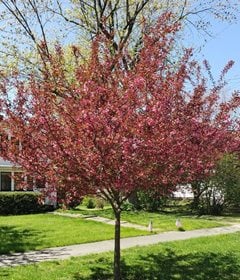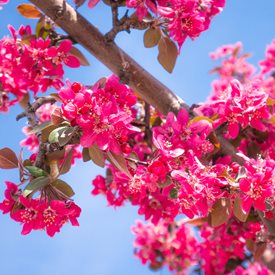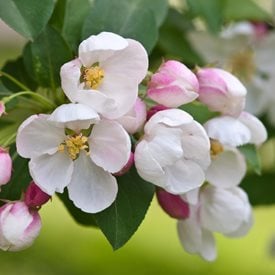Crabapple Trees: Growing, Care and Design Tips
Showy spring flowers and brightly colored fruit make these ornamental trees an attractive addition to any gardenIf you’re looking for a compact, versatile tree that provides interest nearly year-round, you can’t do much better than the crabapple. In addition to dazzling you with breathtaking buds and blossoms in spring, crabapples are also handsome foliage plants in summer and fall, and provide bountiful displays of fruit that linger on the branches well into winter. What’s more, they come in a range of sizes and forms (most no taller than 20 feet) to accommodate nearly any space constraint.
There are hundreds of crabapple varieties, but those featured here are particularly gardenworthy, bred for superior flowering, good fall leaf color, and attractive fruit. Even better, they resist apple scab and other common diseases that have beset crabapples in the past, making them reliable performers year after year.
2025 National Tree of the Year: Show Time™ crabapple from Proven Winners.
On this page: Basics | Planting | Care & Pruning | Pictures | Design Tips | Frequently Asked Questions
- CRABAPPLE BASICS
- PLANTING CRABAPPLE TREES
- CARE & PRUNING
- CRABAPPLE PICTURES
- DESIGN TIPS
- FREQUENTLY ASKED QUESTIONS
CRABAPPLE BASICS
Botanical name:
Malus
Zones:
4-8
Size:
Most grow 15 to 20 feet tall and wide. There are also dwarf and semi-dwarf varieties that range in height from under 5 feet to 10 feet.
Forms:
May be rounded, spreading, columnar, vase-shaped, or weeping, depending on the cultivar.
Exposure:
Full sun, minimum 6 hours per day.
Bloom Time:
Mid to late spring, with the length of bloom ranging from 1 to 2 weeks.
Flowers:
Single, semi-double or fully double in white, pink, magenta, or red. Very fragrant. Many varieties have darker buds that lighten in color as the flowers reach full bloom.
Foliage:
Usually green, but some varieties have foliage with purple, red, or bronze tones. Fall leaf color may be orange, red, gold, or bronze, depending on the cultivar.
Fruit:
Ripens from late summer to mid-fall and often clings to the branches through winter. Usually the fruit is red, resembling small cherries, but some cultivars produce yellow, maroon, or orange fruit.
Growth rate:
Moderate
PLANTING CRABAPPLE TREES
When to plant:
The best time to plant a crabapple tree is in the spring or fall, when the soil is moist and temperatures are cool. (See What to Plant in Your Fall Garden). However, if you avoid freezing temperatures and extreme heat, you can plant a crabapple almost any time of year.
Where to plant:
Crabapples thrive in full sun but don’t like hot weather, preferring climates with temperate summers and cold winters. They adapt to most soil conditions, as long as they are planted in well-drained soil. To avoid foliar diseases, plant in a location that offers good air circulation.
How to plant:
Follow the general rules for planting trees: Dig a hole twice as wide and as deep as the rootball and center the tree within the hole with the top of the rootball slightly above ground level. To enrich the soil, mix in some peat moss or compost. Stake if needed, and water deeply after planting.
CRABAPPLE TREE CARE & PRUNING
Watering:
The first year after planting, provide supplemental watering during dry weather so the tree receives at least 1 inch of water per week and up to 2 inches during hot spells. After the roots become established, you will only need to water during prolonged dry periods. To reduce watering frequency, apply a few inches of mulch around the base of the tree (but not touching the trunk) to help retain soil moisture.
Amendments & Fertilizer:
If planted in good, moderately fertile soil, crabapples usually don’t need extra fertilization. However, if you notice poor blooming and fruit production, you can improve soil fertility by top dressing with compost in the spring or by applying a slow-release fertilizer before new growth emerges.
Pruning:
Occasional pruning will help keep crabapple trees healthy and maintain their lovely silhouettes. Crabapples are particularly prone to water sprouts (shoots that grow upward from tree branches) and suckers that form at the base of the tree, which can grow large enough to become additional trunks. These growths should be removed, along with any dead, diseased, or crowded branches.
Pruning is best done in late winter or before flowering in early spring. Avoid over-pruning. Trees need time to form callus over a wound, so it’s best to remove only the branches that need it. Get more pruning advice: Pruning a Crabapple Tree.
Diseases:
Apple scab, cedar apple rust, fire blight, and powdery mildew are the most common diseases to afflict crabapples, particularly non-resistant varieties. Apple scab - a fungal disease that often develops in cool, wet springs - is the most serious problem and can cause leaf spotting and defoliation. These can be avoided by planting newer cultivars bred to resist these diseases and by replacing disease-prone trees with resistant varieties. Any branches that become defoliated due to disease usually leaf back out the following spring.
CRABAPPLE PICTURES
DESIGN TIPS
Because crabapple trees come in an array of sizes, growth habits, and flower colors, they are suitable for a wide range of applications. Here are some ideas for using them in the garden:
- Plant larger varieties for use as specimen or shade trees.
- Use dwarf types in small groupings or as focal points in Asian or cottage gardens.
- Line parkways or sidewalks with trees that have narrow, upright silhouettes.
- Use varieties with symmetrical, rounded forms in formal gardens and courtyards.
- Train to use as an espalier (learn how).
Keep in mind that the fruit of crabapple trees can stain walkways or patios. To avoid that problem, choose a non-fruiting cultivar, such as ‘Prairie Rose’.
FREQUENTLY ASKED QUESTIONS
Are crabapple trees related to apple trees? Yes. Both trees share the same genus (Malus) and many of the same characteristics. However, a crabapple has smaller, tarter fruit, ranging in size from ¼ inch to 2 inches in diameter.
Do all crabapples bear fruit? While most flowering crabapples develop fruit, there are some “non-fruiting” cultivars that produce very small fruit or none at all.
Is the fruit edible? Unlike apples, most crabapples are too tart and mouth-puckering to be eaten out of hand, but they are perfectly edible and often used to make jams and jellies. In winter, they are a great source of food for many types of birds and other wildlife. In general, the smaller the fruit, the more sour the taste.
Why isn’t my crabapple tree blooming? Some crabapples are alternate flowering, meaning they will bloom heavily one year and sparsely or not at all the next. Older trees that are past their prime may also stop flowering every year. Lack of enough sunlight can also result in few or no flowers.


















